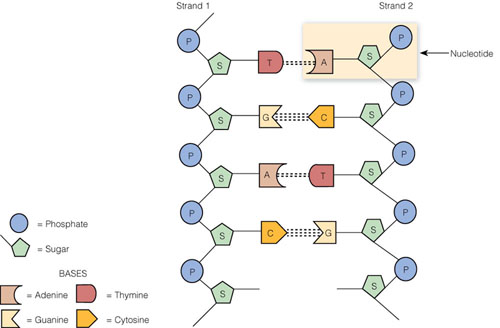(The ' symbol is read as "prime." By writing 5' it is saying five prime. The sugar deeoxyribose consists of 5 carbon molecules with each "prime" simply referring to the specific carbon molecule. and its location. The phosphate group is hence attached to the fifth carbon while the hydroxyl group to the third carbon)
 After two chains of nucleotides are formed, the nitrogenous bases will pair up. Adenine binds thymine bases via two hydrogen bonds and guanine with cytosine via three hydrogen bonds. The two chains will face each other and run in an anti-parallel fashion. The double strand will twist into the shape of a double helix.
After two chains of nucleotides are formed, the nitrogenous bases will pair up. Adenine binds thymine bases via two hydrogen bonds and guanine with cytosine via three hydrogen bonds. The two chains will face each other and run in an anti-parallel fashion. The double strand will twist into the shape of a double helix.
Nucleosomes:
The double helix structure of DNA consists of major and minor grooves that can expose chemical groups capable of forming hydrogen bonds. Eukaryotic DNA will wrap itself around an octamer of proteins called histones (8 histones in total) to form a nucleosome. Nucleosomes serve to protect and supercoil DNA for use during meiosis or mitosis. Although it cannot be transcribed when it is coiled, it makes transport easier. Certain segments of the DNA will be permanently supercoiled but the segments might change between cell types(heterochromatin)
Intron: only found in eukaryotic DNA that doesn't code for proteins but can be cut out by enzymes as RNA changes into mature mRNA. Repetitive sequences
Exon: section of the gene that codes for proteins (expression). Unique sequences
 After two chains of nucleotides are formed, the nitrogenous bases will pair up. Adenine binds thymine bases via two hydrogen bonds and guanine with cytosine via three hydrogen bonds. The two chains will face each other and run in an anti-parallel fashion. The double strand will twist into the shape of a double helix.
After two chains of nucleotides are formed, the nitrogenous bases will pair up. Adenine binds thymine bases via two hydrogen bonds and guanine with cytosine via three hydrogen bonds. The two chains will face each other and run in an anti-parallel fashion. The double strand will twist into the shape of a double helix.Nucleosomes:
The double helix structure of DNA consists of major and minor grooves that can expose chemical groups capable of forming hydrogen bonds. Eukaryotic DNA will wrap itself around an octamer of proteins called histones (8 histones in total) to form a nucleosome. Nucleosomes serve to protect and supercoil DNA for use during meiosis or mitosis. Although it cannot be transcribed when it is coiled, it makes transport easier. Certain segments of the DNA will be permanently supercoiled but the segments might change between cell types(heterochromatin)
Intron: only found in eukaryotic DNA that doesn't code for proteins but can be cut out by enzymes as RNA changes into mature mRNA. Repetitive sequences
Exon: section of the gene that codes for proteins (expression). Unique sequences
No comments:
Post a Comment